Set Of 6 Trade Cards From Holland
(Published: November, 2009, Volume 9, Number 3, Issue #29) (Table Of Contents)(Author: Larry Fillion)
A few years ago, I purchased this set of 6 trade cards from Holland. I could not translate them and so I threw them in a draw.
One day, I was reading the 'Topical Time' which is a newsletter from the American Topical Association (ATA) and I noticed that
each member can get some free translations each year. I sent off images of the cards and a few weeks later, I received the
translations. The ATA has a nice website at http://www.americantopicalassn.org/.
Below are the front and back of the trade cards with translations. I do not know much else about these cards - if you have
any more information, please let me know.
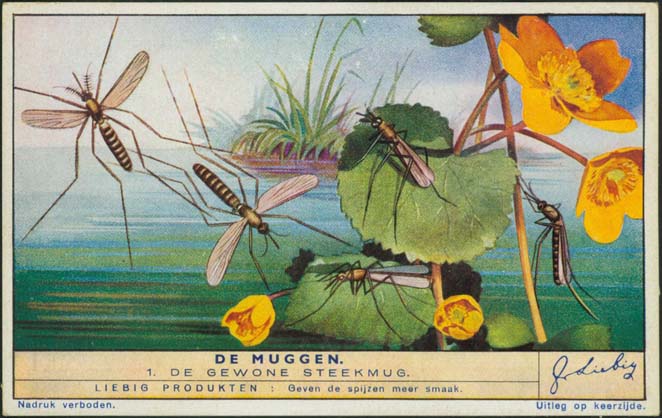
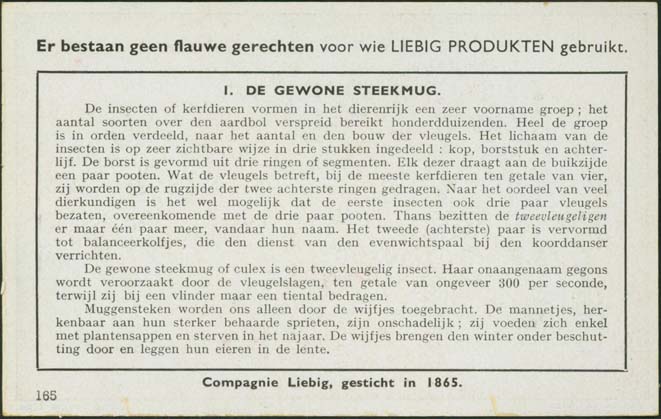
Card #1: The Common Biting Mosquito
The insects of the carving animals are a very important group in the animal world. The different kinds, spread around the globe, reach the hundreds of thousands. The whole group is divided in an orderly manner according to the number and the build of the wings. The body of the insect is very obviously divided in three parts: head, breast, and anterior. The breast is formed of three rings of segments. Each one of these has a pair of legs on the underside. Concerning the wings: most of the time, they number four and are carried on the back of the two last rings. According to many zoologists, it is possible that the first insects had three pairs of wings, conforming to the three pairs of legs. Now the two winged ones only have a pair, therefore their name. The second (posterior) pair has been transformed into butt balancers, which have the function of the balance pole of the high wire dancer. The common mosquito, or culex, is a two-winged insect. Its unpleasant buzz is created by the movements of the wings, numbering approximately three hundred movements per second. With a butterfly, it is only ten times per second.
Only the female mosquito bites. The males, recognized by their more hairy feelers, are harmless. They only feed on plant sap and die in the fall. The females spend the winter under cover and lay their eggs in the Spring.

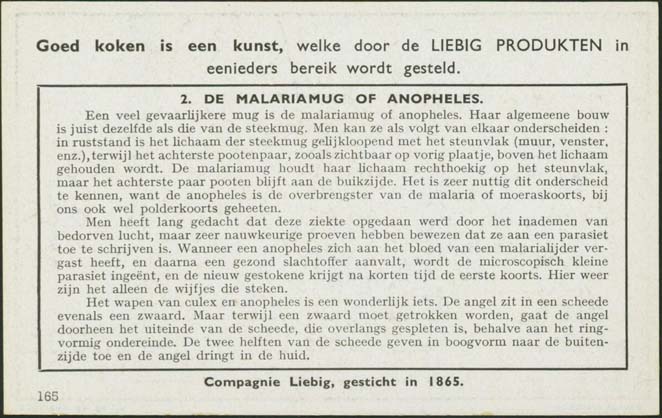
Card #2: The Malaria Mosquito of Anopheles
A much more dangerous mosquito is the malaria mosquito of Anopheles. Its general build is just the same as the common mosquito. We can differentiate them as follows: While at rest, the body of the common mosquito is parallel with its support (wall, window, etc.), while the back legs, as visible on the previous picture, are held above the body. The malaria mosquito holds the body at right angles to its support, but keeps the back legs on the underside. It's very beneficial to know the difference because the Anopheles carries malaria, or swamp fever, also known here as polder fever. People have thought for a long time that the disease came by breathing foul air, but careful research has proven that it comes from a parasite. When an Anopheles has fed on the blood of a malaria sufferer and then attacks a healthy victim, the microscopic parasite is inoculated, and this person will develop, in a short time, the first fever. There again, it's only the female that bites
The weapon of the culex and the Anopheles is a wonderful thing. The stinger sits in a sheath, just like a sword. But, as a sword has to be taken out, the stinger goes through the sheath, which is split lengthwise, except at its round end. The two parts of the sheath form an outward bulging bow, and the stinger enters the skin.
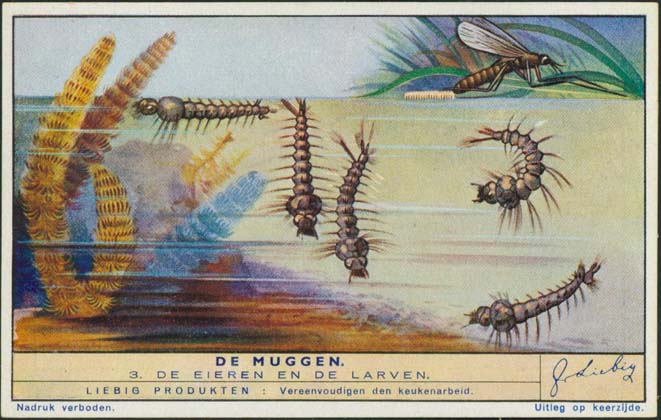
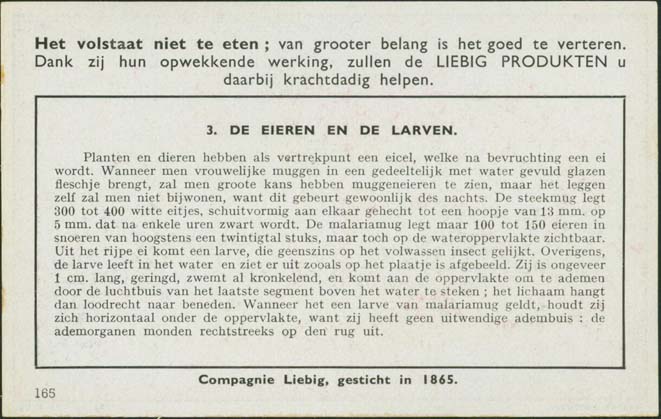
Card #3: The Eggs and the Larvae
Plants and animals have as starting point an egg cell, which after fertilization becomes an egg. When one puts a female mosquito in a glass bottle partially filled with water, one will have a great chance to see mosquito eggs, but the laying itself will not be seen because it usually happens at night. The common mosquito lays from 300 to 400 white eggs attached to each other in a little pile 13 mm X 5 mm, which turns black after a few hours. The malaria mosquito lays only 100 to 150 eggs in strings of no more than 20, but still visible on top[ of the water. From a mature egg you will get a larva which looks nothing like an adult insect. Besides, the larva lives in the water and looks like what you see in the picture. It's approximately 1 cm long, ringed, and swims, twisting, and comes to the surface to breathe through an air pipe in the last segment, which it sticks above water; the body hangs down perpendicularly. Regarding the larva of the malaria mosquito, it keeps itself horizontal under the surface of the water, because it does not have an external breathing pipe: the breathing organs come directly out of its back.
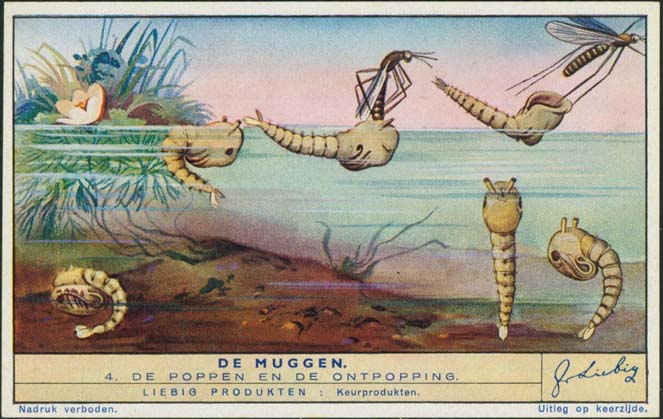
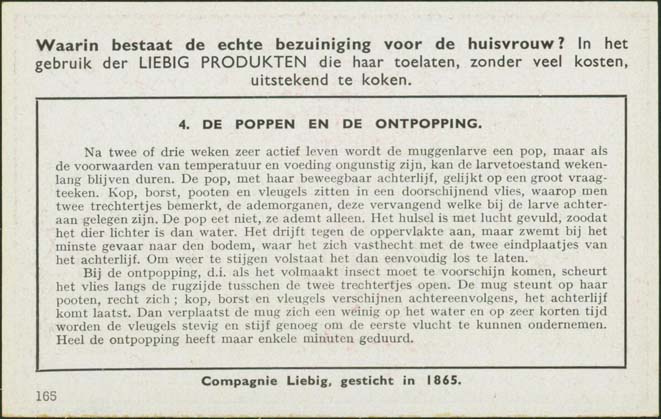
Card #4: The Pupa and Its Emergence
After 2 or 3 weeks of very active living, the mosquito larva becomes a pupa, but if the weather or the feed is unfavorable, the larval state may remain for many weeks. The pupa with its maneuverable rear body looks like a big question mark. Head, breast, legs and wings are contained in a see-through membrane on which you can observe two funnels, the breathing organs changed from the larval stage, which were in the rear. The pupa does not eat; it only breathes. Its membrane is filled with air so that the animal is lighter than water. It floats near the surface, but swims to the bottom at the least hint of danger, where it hooks on with the two end pieces of the anterior. To surface again, it suffices to merely let these loose.
By the change to adulthood, that is, when the complete insect has to appear, the membrane rips open on the backside, between the two breathing funnels. The mosquito leans on its feet, and straightens up; head, breast and wings appear afterwards, its anterior last. Then the mosquito moves a little under water, and in a short time the wings are sturdy and stiff enough to make a first flight. The whole transformation took only a few minutes.
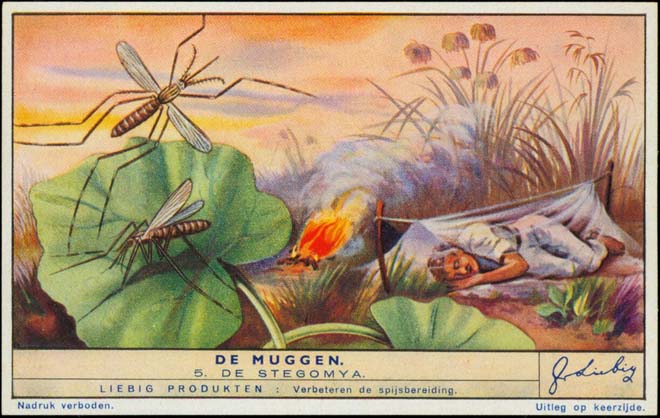

Card #5: The Stegomya
Another dangerous mosquito is the Stegomya. Luckily, not indigenous in our regions. And where it was very numerous, it has disappeared completely, namely, in West Indies, Mexico, Central America, Brazil and the West Coast of Africa. In Europe, the insect lived in Portugal and Italy and is now totally eradicated. This mosquito carries and spreads the microbe of Yellow Fever, the tropical disease that has caused incalculable number of victims. In 1898, in Rio de Janeiro, the epidemic of Yellow Fever infected thousands of inhabitants, of which 95% died. Here again, the females are dangerous. From her sting the microbe infects healthy people after the insect has gorged itself on the blood of a sick person. They have noticed that the Stegomya prefers the blood of a white person over that of a black person. After a scrumptious meal, the female lays its eggs in still-standing water (roofs, potsherds, old boxes, sewers). The eggs resist cold and drought. In 10-12 days, the body changes have taken place and the insect can live 3-4 months.
Yellow Fever is just about eradicated because of the relentless fight against its carriers. Raising specific kinds of fish that can eat small insects is the main reason that that the stegomya has been destroyed. To be safe, people sleep under a mosquito net.
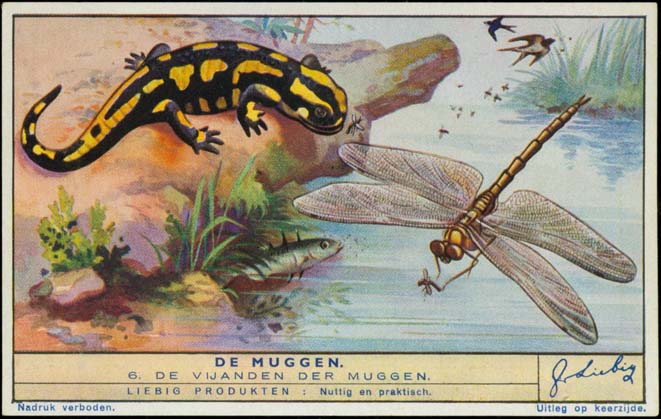

Card #6: Enemies of the Mosquito
Many times, life is represented as a better, endless fight where all beings are forced to protect themselves against enemies, in which the weak ones succumb if they don't have a means to overcome their weaknesses. With mosquitoes, it seems its fertility is its defense. Its enemies destroy an innumerable amount, and good too, otherwise, without this slaughter, life would be impossible in many places. In fact, one female can lay eggs 8 to 10 times in a season. If each time 200 eggs are produced, and half of them are female, then by the next year, the number of females would be a number with 14 zeros. The natural enemies of the mosquito are the insect eaters, some living in water and destroying a large number of the larvae: the water beetle, the salamander, the frog and the stickleback. Adult mosquitoes are pursued mercilessly by birds, especially swallows. Also, bats devour an innumerable amount. An American naturalist brought together a big colony of bats. These small benefactors of mankind catch every night 250 million mosquitoes.
*If any reader has any other information on these cards, please contact me at malariastamps@yahoo.com


Card #1: The Common Biting Mosquito
The insects of the carving animals are a very important group in the animal world. The different kinds, spread around the globe, reach the hundreds of thousands. The whole group is divided in an orderly manner according to the number and the build of the wings. The body of the insect is very obviously divided in three parts: head, breast, and anterior. The breast is formed of three rings of segments. Each one of these has a pair of legs on the underside. Concerning the wings: most of the time, they number four and are carried on the back of the two last rings. According to many zoologists, it is possible that the first insects had three pairs of wings, conforming to the three pairs of legs. Now the two winged ones only have a pair, therefore their name. The second (posterior) pair has been transformed into butt balancers, which have the function of the balance pole of the high wire dancer. The common mosquito, or culex, is a two-winged insect. Its unpleasant buzz is created by the movements of the wings, numbering approximately three hundred movements per second. With a butterfly, it is only ten times per second.
Only the female mosquito bites. The males, recognized by their more hairy feelers, are harmless. They only feed on plant sap and die in the fall. The females spend the winter under cover and lay their eggs in the Spring.


Card #2: The Malaria Mosquito of Anopheles
A much more dangerous mosquito is the malaria mosquito of Anopheles. Its general build is just the same as the common mosquito. We can differentiate them as follows: While at rest, the body of the common mosquito is parallel with its support (wall, window, etc.), while the back legs, as visible on the previous picture, are held above the body. The malaria mosquito holds the body at right angles to its support, but keeps the back legs on the underside. It's very beneficial to know the difference because the Anopheles carries malaria, or swamp fever, also known here as polder fever. People have thought for a long time that the disease came by breathing foul air, but careful research has proven that it comes from a parasite. When an Anopheles has fed on the blood of a malaria sufferer and then attacks a healthy victim, the microscopic parasite is inoculated, and this person will develop, in a short time, the first fever. There again, it's only the female that bites
The weapon of the culex and the Anopheles is a wonderful thing. The stinger sits in a sheath, just like a sword. But, as a sword has to be taken out, the stinger goes through the sheath, which is split lengthwise, except at its round end. The two parts of the sheath form an outward bulging bow, and the stinger enters the skin.


Card #3: The Eggs and the Larvae
Plants and animals have as starting point an egg cell, which after fertilization becomes an egg. When one puts a female mosquito in a glass bottle partially filled with water, one will have a great chance to see mosquito eggs, but the laying itself will not be seen because it usually happens at night. The common mosquito lays from 300 to 400 white eggs attached to each other in a little pile 13 mm X 5 mm, which turns black after a few hours. The malaria mosquito lays only 100 to 150 eggs in strings of no more than 20, but still visible on top[ of the water. From a mature egg you will get a larva which looks nothing like an adult insect. Besides, the larva lives in the water and looks like what you see in the picture. It's approximately 1 cm long, ringed, and swims, twisting, and comes to the surface to breathe through an air pipe in the last segment, which it sticks above water; the body hangs down perpendicularly. Regarding the larva of the malaria mosquito, it keeps itself horizontal under the surface of the water, because it does not have an external breathing pipe: the breathing organs come directly out of its back.


Card #4: The Pupa and Its Emergence
After 2 or 3 weeks of very active living, the mosquito larva becomes a pupa, but if the weather or the feed is unfavorable, the larval state may remain for many weeks. The pupa with its maneuverable rear body looks like a big question mark. Head, breast, legs and wings are contained in a see-through membrane on which you can observe two funnels, the breathing organs changed from the larval stage, which were in the rear. The pupa does not eat; it only breathes. Its membrane is filled with air so that the animal is lighter than water. It floats near the surface, but swims to the bottom at the least hint of danger, where it hooks on with the two end pieces of the anterior. To surface again, it suffices to merely let these loose.
By the change to adulthood, that is, when the complete insect has to appear, the membrane rips open on the backside, between the two breathing funnels. The mosquito leans on its feet, and straightens up; head, breast and wings appear afterwards, its anterior last. Then the mosquito moves a little under water, and in a short time the wings are sturdy and stiff enough to make a first flight. The whole transformation took only a few minutes.


Card #5: The Stegomya
Another dangerous mosquito is the Stegomya. Luckily, not indigenous in our regions. And where it was very numerous, it has disappeared completely, namely, in West Indies, Mexico, Central America, Brazil and the West Coast of Africa. In Europe, the insect lived in Portugal and Italy and is now totally eradicated. This mosquito carries and spreads the microbe of Yellow Fever, the tropical disease that has caused incalculable number of victims. In 1898, in Rio de Janeiro, the epidemic of Yellow Fever infected thousands of inhabitants, of which 95% died. Here again, the females are dangerous. From her sting the microbe infects healthy people after the insect has gorged itself on the blood of a sick person. They have noticed that the Stegomya prefers the blood of a white person over that of a black person. After a scrumptious meal, the female lays its eggs in still-standing water (roofs, potsherds, old boxes, sewers). The eggs resist cold and drought. In 10-12 days, the body changes have taken place and the insect can live 3-4 months.
Yellow Fever is just about eradicated because of the relentless fight against its carriers. Raising specific kinds of fish that can eat small insects is the main reason that that the stegomya has been destroyed. To be safe, people sleep under a mosquito net.


Card #6: Enemies of the Mosquito
Many times, life is represented as a better, endless fight where all beings are forced to protect themselves against enemies, in which the weak ones succumb if they don't have a means to overcome their weaknesses. With mosquitoes, it seems its fertility is its defense. Its enemies destroy an innumerable amount, and good too, otherwise, without this slaughter, life would be impossible in many places. In fact, one female can lay eggs 8 to 10 times in a season. If each time 200 eggs are produced, and half of them are female, then by the next year, the number of females would be a number with 14 zeros. The natural enemies of the mosquito are the insect eaters, some living in water and destroying a large number of the larvae: the water beetle, the salamander, the frog and the stickleback. Adult mosquitoes are pursued mercilessly by birds, especially swallows. Also, bats devour an innumerable amount. An American naturalist brought together a big colony of bats. These small benefactors of mankind catch every night 250 million mosquitoes.
*If any reader has any other information on these cards, please contact me at malariastamps@yahoo.com

